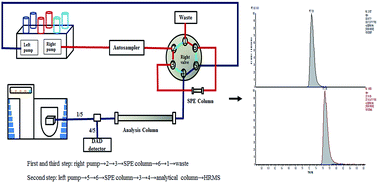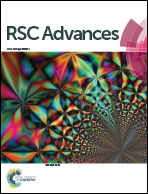Quantitative performance of online SPE-LC coupled to Q-Exactive for the analysis of sofosbuvir in human plasma
Abstract
A quantitative strategy for the analysis of sofosbuvir (SF) in human plasma has been developed with an online solid phase extraction (SPE)-liquid chromatography (LC) coupled with high resolution mass spectrometry (HRMS) system using a MS/MS targeted ion fragmentation scan (t-MS2), targeted-selected ion monitoring (t-SIM) and full MS-SIM (F-SIM) mode. The sample was pretreated automatedly and analyzed within 10 min via an online SPE system equipped with an Oasis®HLB (2.1 × 20 mm, 5 μm) SPE column and LC system with a ZORBAX SB-C18 (4.6 × 250, 5 μm) analytical column. A Q-Exactive hybrid quadrupole-Orbitrap HRMS was utilized for positive identification and quantification. Method detection limits ranged between 0.5 and 2000 ng mL−1 in human plasma for both t-MS2 and t-SIM mode and between 2 and 2000 ng mL−1 for F-SIM mode. In all three modes, the overall intra-day and the inter-day variations were less than 8.07%. The recovery of all three methods was in the range of 92.06–107.20% with RSD% less than 3.90%. The matrix effect of all three methods was in the range of 94.82–101.89% with RSD% less than 7.69%. The optimized two methods (t-MS2 and t-SIM) demonstrated good performance in terms of specificity, lower limit of quantification (LLOQ), linearity, recovery, precision and accuracy.


 Please wait while we load your content...
Please wait while we load your content...